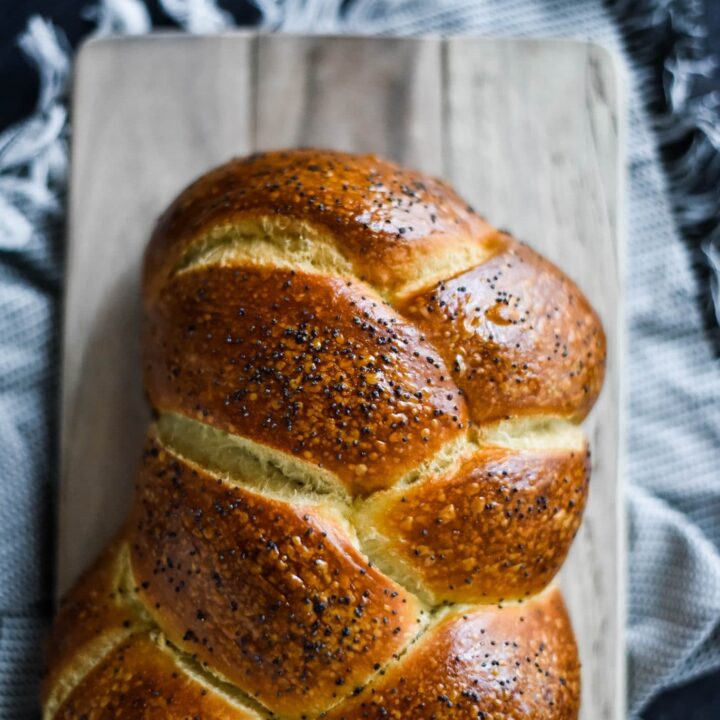Sourdough Challah
4.5
(111)
Your folders
Your folders
Prep Time: 15 hours
Cook Time: 45 minutes
Total: 15 hours, 45 minutes
Servings: 12
Author : Jenni

Ingredients
Export 6 ingredients for grocery delivery
Instructions
Step 1
The levain is like a bigger, specific hydration starter. You need to use 1/2 cup of fed and active 100% hydration starter to make this stiff 50% hydration levain.
Step 2
In a medium mixing bowl, combine the active 100% hydration starter with the 113 grams warm water and the 226 grams bread flour. Mix until combined. This is a stiff starter, so it will take some work to get all the flour mixed in. Do not add extra water. You might need to do a little kneading to get it to all mix in. If all the flour won’t mix in, its ok, just get as much as you can.
Step 3
Cover the bowl with a lid or plastic wrap and allow to sit on the counter overnight 8-12 hours.
Step 4
In the morning, get out a large mixing bowl.
Step 5
In the large mixing bowl, whisk together the 60 grams warm water, eggs, salt, vegetable oil and honey. Whisk until the salt is dissolved.
Step 6
With your hands or a wooden spoon, mix the bread flour in all at once.
Step 7
When the mixture is a shaggy ball, scrape it out onto your work surface.
Step 8
Add the levain from the night before, and knead until the dough is smooth (it should take about 10 minutes by hand). You might need to lightly sprinkle your counter with a small amount of flour as you knead to keep the dough from sticking. The dough will be firm and should feel almost like modeling clay and should be easy to work with even if a little bit sticky. If the dough is too firm to knead easily, add a tablespoon or two of water to it. If the dough is too wet, add a tablespoon or two of flour.
Step 9
Place the dough in a clean oiled bowl and cover with plastic wrap.
Step 10
Allow the dough to ferment at room temperature for 2 hours. It will probably not rise much, if at all.
Step 11
Line a baking sheet with parchment paper.
Step 12
Divide the dough into four even balls (for a four strand challah. If you want to do a 6 strange, divide the dough into 6 balls).
Step 13
Roll each ball into a long thin strip the same length as your baking sheet, working from the middle, out. If the dough is too elastic and keeps shrinking on you, cover the strips with a cloth and walk away for 10 minutes while the dough rests.
Step 14
Place the strips on the baking sheet and bring the top points together. Pinch the four strands together.
Step 15
Starting with the strand on the right, pass it over the next strand, under the third strand, and over the fourth strand on the left.
Step 16
Repeat with the strand that is now on the right, passing it over, under, and over the other strands.
Step 17
Continue braiding until you reach the end.
Step 18
Pinch the ends together and tuck both the top and bottom under the loaf a little so you don’t see the pinched ends.
Step 19
Cover the baking sheet with plastic wrap and allow the loaf to proof until tripled in size, about 5 hours. The time it takes will depend on the temperature and humidity level in your house, if it is cooler it could take longer, and if it is warmer it could take less time. Watch the dough, not the clock. It will be fully proofed when you can gently dent it with your knuckle and the dough springs back.
Step 20
Arrange the oven racks so you have one in the upper third of your oven, with nothing above it.
Step 21
Preheat your oven to 350 F and let it get nice and hot - at least 15-20 minutes before baking.
Step 22
In a small bowl, beat the remaining egg with a pinch of salt.
Step 23
Brush the egg glaze over the loaf.
Step 24
If desired, you can sprinkle the loaf with poppy seeds or sesame seeds, or you can leave it plain.
Step 25
Bake for 35 to 40 minutes, or until well browned. After the first 20 minutes of baking, rotate the baking sheet in the oven to promote even browning. If the bread is browning too fast, tent it with foil.
Step 26
Remove the bread from the baking sheet and cool completely on a wire rack. Some baking still happens while it is cooling, so make sure you wait until it is completely and totally cool before slicing it.